كتاب International Human Rights Law Cases, Materials, Comm entary part 1
: Book Description This course book offers a trajectory through the regime of international human rights law€– its rules, institutions, and processes. It does not confine itself to the international dimension, however. Although human rights have migrated to international law since the Second World War, they live in a permanent nostalgia for where they come from:€ the liberal constitutions of the late eighteenth and nineteenth centuries, when they emerged as the Enlightenment’s most visible response to the tyranny of monarchs and to the weight of tradition and prejudice. And as we shall see, the colonization of international law by human rights perfectly illustrates the formation of a ‘selfcontained regime’€ – one of those regimes that international lawyers are sometimes tempted to ignore, because they know they cannot be domesticated entirely. The choice of materials seeks to reflect this hybrid character of human rights. The book collects cases, diplomatic documents, or comments. It places these materials into perspective, and it seeks to provide the reader with a robust analytical structure, which should help improve understanding of how they fit within a broader framework. A consistent effort has been made, both in the selection of texts and in the commentary, to highlight the specificity of human rights. For although human rights may have escaped the confines of the territory of domestic constitutions, they have not dissolved fully into international law and in fact, they resist assimilation. International human rights bodies and domestic courts are in constant dialogue with each other. International human rights courts are under the permanent temptation to mutate into constitutional courts. The domestic judge in turn tends to aggrandize his or her power in the name of bringing home values that are universal and rules that are supranational€– but, by invoking international law, the domestic judge also transforms it into something else, that is better suited to the regulation of the relationships between the State and the individual or between individuals, than to the relationships among States. All this combines to form a unique human rights grammar which this book seeks to bring to light. Because this grammar is best illustrated by comparing international jurisprudence with the treatment of human rights arguments before national authorities€– in particular judicial authorities€– I have extensively relied شرح الكتاب يقدم كتاب الدورة هذا مسارًا من خلال نظام حقوق الإنسان الدولية law € - قواعدها ومؤسساتها وعملياتها. انها لا تقتصر على الدولية البعد ، ومع ذلك. على الرغم من انتقال حقوق الإنسان إلى القانون الدولي منذ الحرب العالمية الثانية ، وهم يعيشون في حنين دائم إلى حيث يأتون من:  الدساتير الليبرالية في أواخر القرن الثامن عشر والتاسع عشر ، متى لقد ظهروا على أنهم رد فعل التنوير الأكثر وضوحا على استبداد الملوك ولثقل التقاليد والتعصب. وكما سنرى ، الاستعمار يوضح القانون الدولي من خلال حقوق الإنسان تمامًا تشكيل مفهوم "قائم بذاته النظام "- أحد تلك الأنظمة التي يكون المحامون الدوليون في بعض الأحيان يميلون إلى التجاهل ، لأنهم يعرفون أنه لا يمكن تدجينهم بالكامل. يسعى اختيار المواد إلى عكس هذا الطابع الهجين لحقوق الإنسان. الكتاب يجمع القضايا أو الوثائق الدبلوماسية أو التعليقات. يضع هذه المواد في منظور ، ويسعى إلى تزويد القارئ بهيكل تحليلي قوي ، وهو ما ينبغي تساعد في تحسين فهم كيفية ملاءمتها لإطار عمل أوسع. متسقة وقد بُذل جهد ، سواء في اختيار النصوص أو في التعليق ، لإبرازها خصوصية حقوق الإنسان. على الرغم من أن حقوق الإنسان قد تكون قد تجاوزت الحدود من أراضي الدساتير المحلية ، لم يتم حلها بالكامل في الدساتير الدولية القانون وفي الواقع ، إنهم يقاومون الاستيعاب. هيئات حقوق الإنسان الدولية والمحلية المحاكم في حوار مستمر مع بعضها البعض. المحاكم الدولية لحقوق الإنسان هي تحت الإغراء الدائم للتحول إلى محاكم دستورية. القاضي المحلي بدوره يميل إلى تضخيم سلطته أو قوتها باسم جلب القيم المنزلية التي هي قواعد عالمية وقواعد فوق وطنية - ولكن ، من خلال الاحتجاج بالقانون الدولي ، فإن يحولها القاضي المحلي أيضًا إلى شيء آخر ، يكون أكثر ملاءمة للوائح للعلاقات بين الدولة والفرد أو بين الأفراد ، من العلاقات بين الدول. كل هذا يتحد لتشكيل فريد من حقوق الإنسان القواعد النحوية التي يسعى هذا الكتاب إلى تسليط الضوء عليها. لأن أفضل توضيح لهذه القواعد من خلال مقارنة الفقه الدولي بمعالجة حجج حقوق الإنسان أمام السلطات الوطنية .أوليفييه دي شوتر - ❰ له مجموعة من الإنجازات والمؤلفات أبرزها ❞ International Human Rights Law Cases, Materials, Comm entary part 1 ❝ ❞ International Human Rights Law Cases, Materials, Comm entary part 15 ❝ ❞ International Human Rights Law Cases, Materials, Comm entary part 20 ❝ ❞ International Human Rights Law Cases, Materials, Comm entary part 14 ❝ ❞ International Human Rights Law Cases, Materials, Comm entary part 16 ❝ ❞ International Human Rights Law Cases, Materials, Comm entary part 5 ❝ ❞ International Human Rights Law Cases, Materials, Comm entary part 9 ❝ ❞ International Human Rights Law Cases, Materials, Comm entary part 12 ❝ ❞ International Human Rights Law Cases, Materials, Comm entary part 8 ❝ الناشرين : ❞ جميع الحقوق محفوظة للمؤلف ❝ ❱
من كتب القانون باللغة الأنجليزية English Law Books - مكتبة كتب علوم سياسية وقانونية.

قراءة كتاب International Human Rights Law Cases, Materials, Comm entary part 1 أونلاين
معلومات عن كتاب International Human Rights Law Cases, Materials, Comm entary part 1:
This course book offers a trajectory through the regime of international human rights
law€– its rules, institutions, and processes. It does not confine itself to the international
dimension, however. Although human rights have migrated to international law
since the Second World War, they live in a permanent nostalgia for where they come
from:€ the liberal constitutions of the late eighteenth and nineteenth centuries, when
they emerged as the Enlightenment’s most visible response to the tyranny of monarchs
and to the weight of tradition and prejudice. And as we shall see, the colonization
of international law by human rights perfectly illustrates the formation of a ‘selfcontained
regime’€ – one of those regimes that international lawyers are sometimes
tempted to ignore, because they know they cannot be domesticated entirely.
The choice of materials seeks to reflect this hybrid character of human rights. The book
collects cases, diplomatic documents, or comments. It places these materials into perspective,
and it seeks to provide the reader with a robust analytical structure, which should
help improve understanding of how they fit within a broader framework. A consistent
effort has been made, both in the selection of texts and in the commentary, to highlight
the specificity of human rights. For although human rights may have escaped the confines
of the territory of domestic constitutions, they have not dissolved fully into international
law and in fact, they resist assimilation. International human rights bodies and domestic
courts are in constant dialogue with each other. International human rights courts are
under the permanent temptation to mutate into constitutional courts. The domestic judge
in turn tends to aggrandize his or her power in the name of bringing home values that
are universal and rules that are supranational€– but, by invoking international law, the
domestic judge also transforms it into something else, that is better suited to the regulation
of the relationships between the State and the individual or between individuals,
than to the relationships among States. All this combines to form a unique human rights
grammar which this book seeks to bring to light. Because this grammar is best illustrated
by comparing international jurisprudence with the treatment of human rights arguments
before national authorities€– in particular judicial authorities€– I have extensively relied
شرح الكتاب
يقدم كتاب الدورة هذا مسارًا من خلال نظام حقوق الإنسان الدولية
law € - قواعدها ومؤسساتها وعملياتها. انها لا تقتصر على الدولية
البعد ، ومع ذلك. على الرغم من انتقال حقوق الإنسان إلى القانون الدولي
منذ الحرب العالمية الثانية ، وهم يعيشون في حنين دائم إلى حيث يأتون
من: Â الدساتير الليبرالية في أواخر القرن الثامن عشر والتاسع عشر ، متى
لقد ظهروا على أنهم رد فعل التنوير الأكثر وضوحا على استبداد الملوك
ولثقل التقاليد والتعصب. وكما سنرى ، الاستعمار
يوضح القانون الدولي من خلال حقوق الإنسان تمامًا تشكيل مفهوم "قائم بذاته
النظام "- أحد تلك الأنظمة التي يكون المحامون الدوليون في بعض الأحيان
يميلون إلى التجاهل ، لأنهم يعرفون أنه لا يمكن تدجينهم بالكامل.
يسعى اختيار المواد إلى عكس هذا الطابع الهجين لحقوق الإنسان. الكتاب
يجمع القضايا أو الوثائق الدبلوماسية أو التعليقات. يضع هذه المواد في منظور ،
ويسعى إلى تزويد القارئ بهيكل تحليلي قوي ، وهو ما ينبغي
تساعد في تحسين فهم كيفية ملاءمتها لإطار عمل أوسع. متسقة
وقد بُذل جهد ، سواء في اختيار النصوص أو في التعليق ، لإبرازها
خصوصية حقوق الإنسان. على الرغم من أن حقوق الإنسان قد تكون قد تجاوزت الحدود
من أراضي الدساتير المحلية ، لم يتم حلها بالكامل في الدساتير الدولية
القانون وفي الواقع ، إنهم يقاومون الاستيعاب. هيئات حقوق الإنسان الدولية والمحلية
المحاكم في حوار مستمر مع بعضها البعض. المحاكم الدولية لحقوق الإنسان هي
تحت الإغراء الدائم للتحول إلى محاكم دستورية. القاضي المحلي
بدوره يميل إلى تضخيم سلطته أو قوتها باسم جلب القيم المنزلية التي
هي قواعد عالمية وقواعد فوق وطنية - ولكن ، من خلال الاحتجاج بالقانون الدولي ، فإن
يحولها القاضي المحلي أيضًا إلى شيء آخر ، يكون أكثر ملاءمة للوائح
للعلاقات بين الدولة والفرد أو بين الأفراد ،
من العلاقات بين الدول. كل هذا يتحد لتشكيل فريد من حقوق الإنسان
القواعد النحوية التي يسعى هذا الكتاب إلى تسليط الضوء عليها. لأن أفضل توضيح لهذه القواعد
من خلال مقارنة الفقه الدولي بمعالجة حجج حقوق الإنسان
أمام السلطات الوطنية .
للكاتب/المؤلف : أوليفييه دي شوتر .
دار النشر : جميع الحقوق محفوظة للمؤلف .
سنة النشر : 2010م / 1431هـ .
عدد مرات التحميل : 1590 مرّة / مرات.
تم اضافته في : السبت , 29 فبراير 2020م.
حجم الكتاب عند التحميل : 8.4 ميجا بايت .
تعليقات ومناقشات حول الكتاب:
: Book Description
This course book offers a trajectory through the regime of international human rights
law€– its rules, institutions, and processes. It does not confine itself to the international
dimension, however. Although human rights have migrated to international law
since the Second World War, they live in a permanent nostalgia for where they come
from:€ the liberal constitutions of the late eighteenth and nineteenth centuries, when
they emerged as the Enlightenment’s most visible response to the tyranny of monarchs
and to the weight of tradition and prejudice. And as we shall see, the colonization
of international law by human rights perfectly illustrates the formation of a ‘selfcontained
regime’€ – one of those regimes that international lawyers are sometimes
tempted to ignore, because they know they cannot be domesticated entirely.
The choice of materials seeks to reflect this hybrid character of human rights. The book
collects cases, diplomatic documents, or comments. It places these materials into perspective,
and it seeks to provide the reader with a robust analytical structure, which should
help improve understanding of how they fit within a broader framework. A consistent
effort has been made, both in the selection of texts and in the commentary, to highlight
the specificity of human rights. For although human rights may have escaped the confines
of the territory of domestic constitutions, they have not dissolved fully into international
law and in fact, they resist assimilation. International human rights bodies and domestic
courts are in constant dialogue with each other. International human rights courts are
under the permanent temptation to mutate into constitutional courts. The domestic judge
in turn tends to aggrandize his or her power in the name of bringing home values that
are universal and rules that are supranational€– but, by invoking international law, the
domestic judge also transforms it into something else, that is better suited to the regulation
of the relationships between the State and the individual or between individuals,
than to the relationships among States. All this combines to form a unique human rights
grammar which this book seeks to bring to light. Because this grammar is best illustrated
by comparing international jurisprudence with the treatment of human rights arguments
before national authorities€– in particular judicial authorities€– I have extensively relied
شرح الكتاب
يقدم كتاب الدورة هذا مسارًا من خلال نظام حقوق الإنسان الدولية
law € - قواعدها ومؤسساتها وعملياتها. انها لا تقتصر على الدولية
البعد ، ومع ذلك. على الرغم من انتقال حقوق الإنسان إلى القانون الدولي
منذ الحرب العالمية الثانية ، وهم يعيشون في حنين دائم إلى حيث يأتون
من: Â الدساتير الليبرالية في أواخر القرن الثامن عشر والتاسع عشر ، متى
لقد ظهروا على أنهم رد فعل التنوير الأكثر وضوحا على استبداد الملوك
ولثقل التقاليد والتعصب. وكما سنرى ، الاستعمار
يوضح القانون الدولي من خلال حقوق الإنسان تمامًا تشكيل مفهوم "قائم بذاته
النظام "- أحد تلك الأنظمة التي يكون المحامون الدوليون في بعض الأحيان
يميلون إلى التجاهل ، لأنهم يعرفون أنه لا يمكن تدجينهم بالكامل.
يسعى اختيار المواد إلى عكس هذا الطابع الهجين لحقوق الإنسان. الكتاب
يجمع القضايا أو الوثائق الدبلوماسية أو التعليقات. يضع هذه المواد في منظور ،
ويسعى إلى تزويد القارئ بهيكل تحليلي قوي ، وهو ما ينبغي
تساعد في تحسين فهم كيفية ملاءمتها لإطار عمل أوسع. متسقة
وقد بُذل جهد ، سواء في اختيار النصوص أو في التعليق ، لإبرازها
خصوصية حقوق الإنسان. على الرغم من أن حقوق الإنسان قد تكون قد تجاوزت الحدود
من أراضي الدساتير المحلية ، لم يتم حلها بالكامل في الدساتير الدولية
القانون وفي الواقع ، إنهم يقاومون الاستيعاب. هيئات حقوق الإنسان الدولية والمحلية
المحاكم في حوار مستمر مع بعضها البعض. المحاكم الدولية لحقوق الإنسان هي
تحت الإغراء الدائم للتحول إلى محاكم دستورية. القاضي المحلي
بدوره يميل إلى تضخيم سلطته أو قوتها باسم جلب القيم المنزلية التي
هي قواعد عالمية وقواعد فوق وطنية - ولكن ، من خلال الاحتجاج بالقانون الدولي ، فإن
يحولها القاضي المحلي أيضًا إلى شيء آخر ، يكون أكثر ملاءمة للوائح
للعلاقات بين الدولة والفرد أو بين الأفراد ،
من العلاقات بين الدول. كل هذا يتحد لتشكيل فريد من حقوق الإنسان
القواعد النحوية التي يسعى هذا الكتاب إلى تسليط الضوء عليها. لأن أفضل توضيح لهذه القواعد
من خلال مقارنة الفقه الدولي بمعالجة حجج حقوق الإنسان
أمام السلطات الوطنية
تعريف القانون باللغة الانجليزية
كلية القانون بالانجليزي
تعريف القانون العام بالانجليزي
كتابة كلمة قانون بالانجليزي
تخصص قانون بالانجليزي
محامي بالانجليزي
ترجمه القانون بالانجليزي
قانوني بالانجليزي
القانون الانجليزي pdf
مادة مصطلحات قانونية باللغة الانجليزية
تحميل كتاب مصطلحات قانونية باللغة الانجليزية pdf
تحميل قاموس قانوني عربي انجليزي pdf
معجم القانون pdf
مصطلحات القانون الجنائي باللغة الانجليزية
جميع الكلمات القانونية باللغة الانجليزية
تعريف القانون باللغة الانجليزية
international human rights law in many areas. At the same time, it is far from perfect.
Accordingly, contrasts between U.S. law and international law in specific areas can help
highlight any needed areas of improvement in either tradition. Also, the emergence of
the United States as the sole superpower in the post–Cold War era makes it ever more
vital for the United States to promote international human rights and humanitarian law.
Yet the U.S. commitment to human rights and humanitarian law has been tepid at best; a
number of important treaties remain unratified, and others have been ratified only with
large numbers of reservations, declarations, and understandings designed to limit their
impact. The tentativeness of this commitment may well stem in part from the unfamiliarity of human rights and humanitarian law to many in the United States, including a
large segment of its legal profession. The comparative analysis with U.S. law may offer a
small contribution to demystifying and clarifying to a U.S. audience the ramifications of
a full commitment to human rights and humanitarian law.
We then address procedural and substantive law, which constitutes the major proportion of the book. In the sections dealing with substantive law, we have focused on issues
the we believe a U.S. law student audience would find especially interesting and timely.
Such issues include abortion, the death penalty, torture, gay rights, war crimes, genocide
and discrimination, freedom of speech, and economic rights.
Finally, we have placed theoretical materials at the end of the book to suggest that a
more abstract and critical treatment of international human rights law and international
humanitarian law may be best approached after one has become familiar with the substantive and procedural law. We have attempted to give the reader a taste of different
theoretical and critical approaches from a variety of viewpoints.
Beyond the pedagogical purposes of this book, we hope that in exposing the law
student to the full range of current human rights and humanitarian legal issues, this
book will illuminate the future promise of human rights and humanitarian law as a
means of protecting individuals and groups facing persecution. The inspiration of that
promise – and the responsibilities it imposes – sustain the efforts of countless advocates
for international human rights and humanitarian law.
We invite our readers – faculty, students, practitioners, and others – to send suggestions and comments as well as any corrections. Rights International can be reached
through its home page at http://www.rightsinternational.org or by e-mail at rightsinternational.org>.
Researching International Human Rights Law
Itis our hope that the casebook will serve as a research aid for practitioners handling cases,
and students and faculty writing about international human rights law topics. Thus, one
purpose of this book is to bring together in a convenient arrangement a large portion of
the impressive body of international human rights and humanitarian case law.
At the same time, it is clear that no single work can possibly be comprehensive. While
the present work provides a useful starting point for research, lawyers and academics will
of course need to supplement its efforts. The human rights litigator and academic should
be aware that library searches, often through hard copies of poorly indexed and dated
materials, will be essential to comprehensive legal analysis. The materials of the United
Nations, for example, are among the most daunting and obscure to research
القانون الدولي لحقوق الإنسان في العديد من المجالات. في الوقت نفسه ، هو أبعد ما يكون عن الكمال.
وفقًا لذلك ، يمكن أن يساعد التناقض بين القانون الأمريكي والقانون الدولي في مجالات محددة
تسليط الضوء على أي مجالات التحسين المطلوبة في أي من التقاليد. أيضا ، ظهور
الولايات المتحدة باعتبارها القوة العظمى الوحيدة في فترة ما بعد الحرب الباردة تجعلها أكثر من أي وقت مضى
حيوية للولايات المتحدة لتعزيز حقوق الإنسان والقانون الدولي الإنساني.
ومع ذلك ، كان التزام الولايات المتحدة بحقوق الإنسان والقانون الإنساني فاترة في أحسن الأحوال ؛ أ
عدد المعاهدات الهامة التي لم يتم التصديق عليها ، وتم التصديق على المعاهدات الأخرى فقط
أعداد كبيرة من التحفظات والإعلانات والتفاهمات المصممة للحد من
تأثير. قد ينبع تجسيد هذا الالتزام جزئياً من عدم الإلمام بحقوق الإنسان والقانون الإنساني إلى الكثيرين في الولايات المتحدة ، بما في ذلك
شريحة كبيرة من مهنتها القانونية. قد يقدم التحليل المقارن مع القانون الأمريكي
مساهمة صغيرة في إزالة الغموض عن الآثار المترتبة على
الالتزام الكامل بحقوق الإنسان والقانون الإنساني.
ثم نتناول القانون الإجرائي والموضوعي الذي يشكل الجزء الأكبر من الكتاب. في الأقسام التي تتناول القانون الموضوعي ، ركزنا على القضايا
نعتقد أن جمهور طلاب القانون الأمريكي سيجد اهتمامًا خاصًا وفي الوقت المناسب.
وتشمل هذه القضايا الإجهاض وعقوبة الإعدام والتعذيب وحقوق المثليين وجرائم الحرب والإبادة الجماعية
والتمييز وحرية التعبير والحقوق الاقتصادية.
وأخيرا ، لقد وضعنا المواد النظرية في نهاية الكتاب لاقتراح أن أ
معالجة أكثر تجريدًا ونقدًا للقانون الدولي لحقوق الإنسان والقانون الدولي
قد يتم التعامل مع القانون الإنساني بشكل أفضل بعد أن يصبح الشخص على دراية بالقانون الموضوعي والإجرائي. لقد حاولنا إعطاء القارئ طعمًا مختلفًا
النهج النظرية والحرجة من مجموعة متنوعة من وجهات النظر.
وراء الأهداف التربوية لهذا الكتاب ، نأمل أن يتم الكشف عن القانون
طالب إلى مجموعة كاملة من حقوق الإنسان الحالية والقضايا القانونية الإنسانية ، هذا
الكتاب سوف ينير وعد المستقبل لحقوق الإنسان والقانون الإنساني باعتباره
وسائل حماية الأفراد والجماعات التي تواجه الاضطهاد. مصدر إلهام لذلك
الوعد - والمسؤوليات التي يفرضها - تدعم جهود عدد لا يحصى من المدافعين
لحقوق الإنسان والقانون الدولي الإنساني.
نحن ندعو قراءنا - أعضاء هيئة التدريس والطلاب والممارسين وغيرهم - لإرسال الاقتراحات والتعليقات وكذلك أي تصحيحات. يمكن الوصول إلى الحقوق الدولية
من خلال صفحتها الرئيسية على الموقع http://www.rightsinternational.org أو عن طريق البريد الإلكتروني على العنوان rightsinternational.org>.
البحث في القانون الدولي لحقوق الإنسان
نأمل أن يكون دفتر الملاحظات بمثابة أداة مساعدة للبحث للممارسين الذين يتعاملون مع الحالات ،
والطلاب وأعضاء هيئة التدريس الكتابة حول مواضيع القانون الدولي لحقوق الإنسان. وبالتالي ، واحد
الغرض من هذا الكتاب هو الجمع بين في ترتيب مناسب جزء كبير من
مجموعة مثيرة للإعجاب من قانون حقوق الإنسان الدولي والسوابق القضائية الإنسانية.
في الوقت نفسه ، من الواضح أنه لا يوجد عمل واحد يمكن أن يكون شاملاً. في حين
يوفر العمل الحالي نقطة انطلاق مفيدة للبحث ، وسوف المحامين والأكاديميين
بالطبع تحتاج إلى تكملة جهودها. محامي حقوق الإنسان والأكاديمي ينبغي
يجب أن تدرك أن عمليات البحث في المكتبات ، غالبًا من خلال نسخ ورقية مفهرسة سيئة ومؤرخة
المواد ، سيكون من الضروري للتحليل القانوني الشامل. المواد المتحدة
الأمم ، على سبيل المثال ، هي من بين أكثرها شاقة وغموض البحث
 مهلاً !
مهلاً !قبل تحميل الكتاب .. يجب ان يتوفر لديكم برنامج تشغيل وقراءة ملفات pdf
يمكن تحميلة من هنا 'تحميل البرنامج'

نوع الكتاب : pdf.
اذا اعجبك الكتاب فضلاً اضغط على أعجبني و يمكنك تحميله من هنا:


كتب اخرى في كتب القانون باللغة الأنجليزية English Law Books
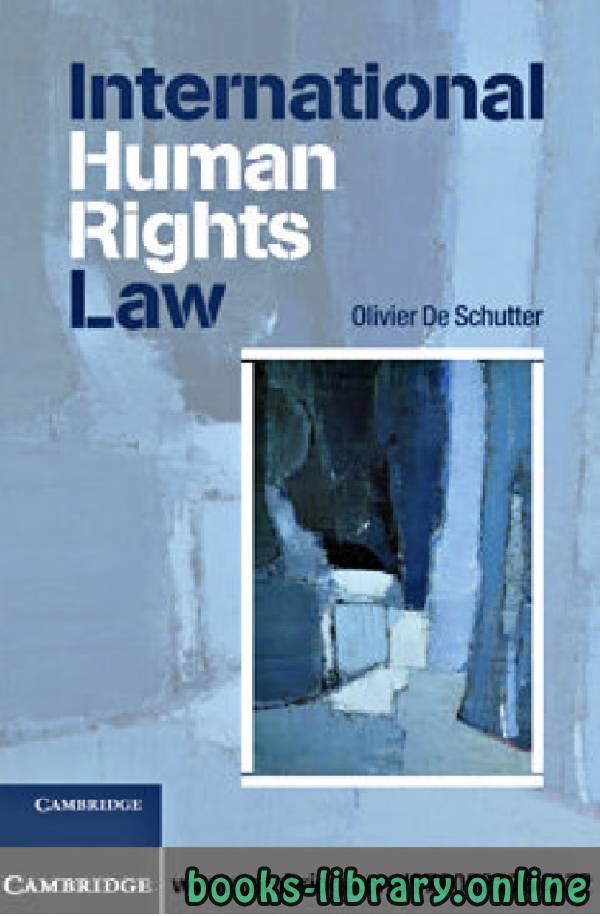
International Human Rights Law Cases, Materials, Comm entary part 2 PDF
قراءة و تحميل كتاب International Human Rights Law Cases, Materials, Comm entary part 2 PDF مجانا

International Human Rights Law Cases, Materials, Comm entary part 3 PDF
قراءة و تحميل كتاب International Human Rights Law Cases, Materials, Comm entary part 3 PDF مجانا

International Human Rights Law Cases, Materials, Comm entary part 4 PDF
قراءة و تحميل كتاب International Human Rights Law Cases, Materials, Comm entary part 4 PDF مجانا

International Human Rights Law Cases, Materials, Comm entary part 5 PDF
قراءة و تحميل كتاب International Human Rights Law Cases, Materials, Comm entary part 5 PDF مجانا
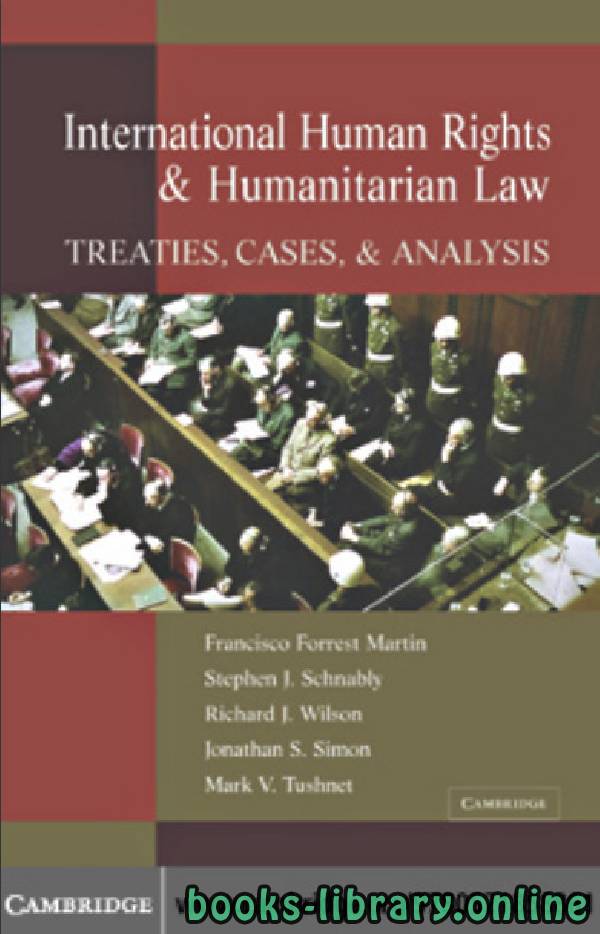
International Human Rights and Humanitarian Law TREATIES, CASES AND ANALYSIS PDF
قراءة و تحميل كتاب International Human Rights and Humanitarian Law TREATIES, CASES AND ANALYSIS PDF مجانا
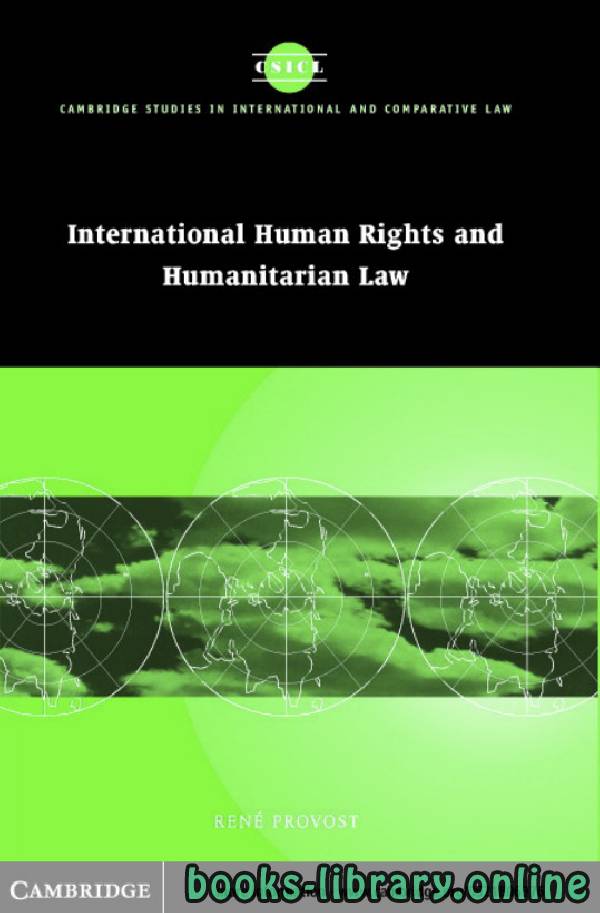
International Human Rights and Humanitarian Law PDF
قراءة و تحميل كتاب International Human Rights and Humanitarian Law PDF مجانا
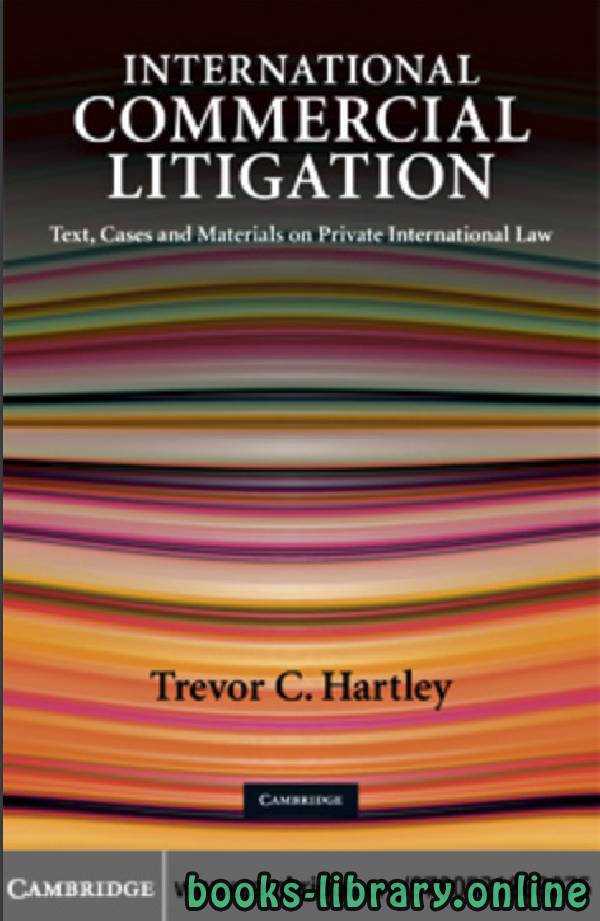
International Commercial Litigation Text, Cases and Materials on Private International Law PDF
قراءة و تحميل كتاب International Commercial Litigation Text, Cases and Materials on Private International Law PDF مجانا
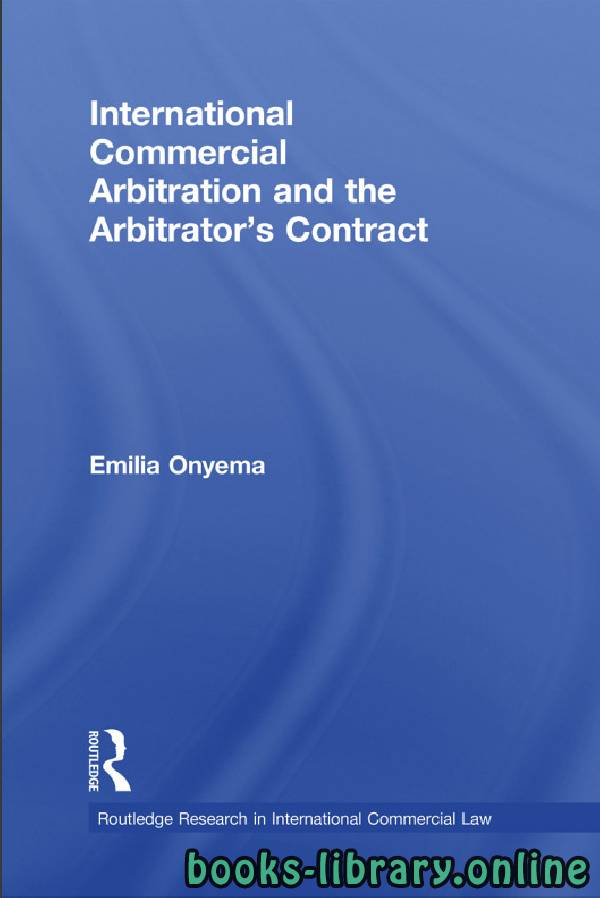
International Commercial Arbitration and the Arbitrator’s Contract PDF
قراءة و تحميل كتاب International Commercial Arbitration and the Arbitrator’s Contract PDF مجانا

